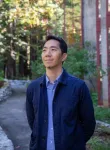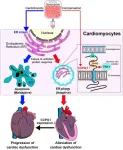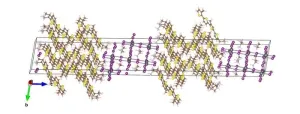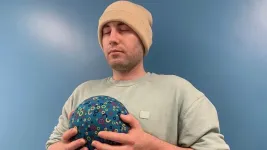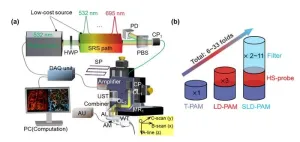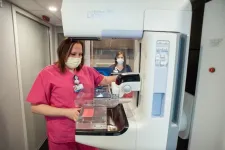(Press-News.org) Cancer is most treatable in its early stages, so finding innovative and non-invasive methods to diagnose cancer early on is crucial for fighting the disease. Liquid biopsies, which require just a simple blood draw, are an emerging technology for non-invasively testing for cancer using DNA or RNA sequencing of a patient’s blood.
Assistant Professor of Biomolecular Engineering Daniel Kim and his lab are developing more accurate and powerful liquid biopsy technologies that take advantage of signals from RNA “dark matter,” an understudied area of the genome. Kim’s new research shows that this genetic material is present in the blood of people with cancer and can be identified to diagnose specific cancer types such as pancreatic, lung, esophageal, and others early in the course of the disease.
Kim’s lab developed an RNA liquid biopsy platform that detects both protein-coding RNA and RNA dark matter in the blood, and showed that this new approach significantly improves the performance of liquid biopsy for cancer diagnosis. This research was published today in the journal Nature Biomedical Engineering.
Focus on ‘dark matter’
While most researchers and companies are pursuing DNA-based liquid biopsy for cancer diagnosis, Kim’s approach is unique in its focus on RNA “dark matter,” specifically noncoding and repetitive RNA.
Most of the three billion base pairs of DNA that make up the human genome are transcribed into RNA, and all of the RNA is collectively known as the transcriptome. The most commonly recognized function of RNA is to code for proteins in the body, but 75% of the human genome generates noncoding RNA that does not code for proteins.
A substantial portion of these noncoding RNAs are derived from repetitive elements, and these RNAs can travel out of the cell from which they originate and into the bloodstream. A healthy individual’s blood typically would have very few of these repetitive noncoding RNAs. However, Kim’s research has shown that even at the earliest stages of cancer, many of these repetitive RNAs are secreted out of cancer cells, making them potent biomarkers of early-stage disease.
RNA liquid biopsy technology developed by the Kim lab aims to detect cancer by sequencing “cell-free RNA” in a patient’s blood to test for the presence of both protein-coding and repetitive noncoding RNA.
Kim’s lab created a cell-free RNA sequencing and analysis platform called COMPLETE-seq to identify repetitive noncoding RNAs that are typically overlooked. After a patient’s blood is drawn, this comprehensive approach analyzes the sample for all of the annotated areas of the transcriptome — the tens of thousands of RNAs that have already been well-documented— plus all of the five million noncoding repetitive elements that Kim’s lab also focuses on.
“If you look at these different cancers, each has its own characteristic cell-free RNA profile, but a lot of these RNAs are coming from the millions of repeat elements that are found throughout the genome,” Kim said. “What we found was that when we trained machine learning models for cancer classification, the models perform better when you introduce these repetitive cell-free RNAs as additional features. We see higher sensitivity in terms of detecting cancer, so we think that these repeat elements are actually providing a lot of rich cell-free RNA information that people previously hadn't looked for.”
Improving tests
Other existing liquid biopsy tests have not been very sensitive for early stage cancer, with some tests missing up to 75% of stage I cancers, when the biological signal is low due to the small tumor size. Kim’s paper shows that incorporating repetitive RNA into their liquid biopsy platform greatly increases the biological signal and boosts the performance of machine learning models tasked to identify cancer. As an example, using COMPLETE-seq improved performance to 91% sensitivity for identifying colorectal cancer.
“The value of our study is that we've now shown the potential of these repeat elements for diagnosing disease, so hopefully there'll be a lot of interest in leveraging repetitive RNAs to boost the sensitivity of these multi-cancer early detection tests,” Kim said.
The research findings show that this technology can be used to identify a variety of cancer types. The lab initially focused on pancreatic cancer for this study, as there is an urgent clinical need for pancreatic cancer early detection, as late detection leads to worse outcomes for patients. Pancreatic cancer is also known to be driven by mutations in the KRAS gene, which is also a focus of Kim’s lab.
After verifying findings in pancreatic cancer, the researchers also looked at a variety of other cancers, and plan to look at many more cancer types with additional samples across the progressive stages of cancer. The team is interested in collaborating with clinicians and companies to do this.
Kim’s goal is to develop an RNA liquid biopsy test for multi-cancer early detection, using the rich information from repetitive RNAs to identify and diagnose disease with high sensitivity and specificity. Kim hopes his platform will not only diagnose cancer at the earliest stages but also help guide individualized, precise treatment strategies when the cancer is more treatable. Moreover, his test could help to identify a recurrence of cancer, and also be used to study aging and to diagnose other types of diseases that alter the repetitive RNA landscape, such as Alzheimer’s disease. He recently gave the UCSC Kraw Lecture on “Precision Health for All Through RNA” that laid out his vision for early detection and precise treatment of disease using RNA.
The researchers also used nanopore sequencing to read the cell-free RNAs floating in the blood, which allowed them to generate long-reads and determine the true length of these cell-free RNAs. Kim believes his lab is the first to use nanopore sequencing, a technique pioneered at UC Santa Cruz, for RNA liquid biopsies to diagnose cancer and to determine the full length of these cell-free RNAs. Nanopore sequencing can be performed on a handheld device developed by Oxford Nanopore Technologies called the MinION. This holds promise for carrying out cancer screening in remote or resource-poor settings where larger, more expensive sequencers are not readily available.
“This study would not have been possible without the strong support of the American Cancer Society and all of its generous donors, leadership, staff, and volunteers, as well as all of the hard work of my PhD student Roman Reggiardo (an NIH F99/K00 Fellow now at HHMI Investigator Howard Chang’s lab at Stanford University) and all of our Kim lab members and collaborators,” Kim said.
In addition to his role as an Assistant Professor in the Baskin School of Engineering associated with the Institute for the Biology of Stem Cells, the Genomics Institute, and the Center for Molecular Biology of RNA at UC Santa Cruz, Kim is also an Associate Member of the Canary Center at Stanford for Cancer Early Detection and a Research Scholar of the American Cancer Society.
END
New blood test for noncoding RNA significantly improves cancer detection
A novel liquid biopsy technology developed by UCSC Assistant Professor of Biomolecular Engineering Daniel Kim’s lab leverages RNA “dark matter” to enhance cancer diagnosis
2023-08-31
ELSE PRESS RELEASES FROM THIS DATE:
Largest genetic study of epilepsy to date provides new insights on why epilepsy develops and potential treatments
2023-08-31
Thursday, 31 August 2023: The largest genetic study of its kind, coordinated by the International League Against Epilepsy, including scientists from FutureNeuro at RCSI University of Medicine and Health Sciences, has discovered specific changes in our DNA that increase the risk of developing epilepsy.
The research, published today in Nature Genetics, greatly advances our knowledge of why epilepsy develops and may inform the development of new treatments for the condition.
Epilepsy, a common brain disorder of which there are many different types, is known to have genetic component and to sometimes run in families. Here, researchers compared the DNA from diverse groups of almost ...
Intracellular recycling: the key to surviving potent anti-cancer drugs
2023-08-31
Researchers from Tokyo Medical and Dental University(TMDU) determine how cardiomyocytes protect themselves against anti-cancer medication
Tokyo, Japan – A cell contains many specialized subunits, called organelles, that carry out important tasks such as energy generation, protein synthesis, and calcium outflux. But what happens when something goes wrong with one of the organelles?
In a study recently published in the Journal of the American College of Cardiology: CardioOncology, researchers from Tokyo Medical and Dental University(TMDU) have ...
Growing triple-decker hybrid crystals for lasers
2023-08-31
By controlling the arrangement of multiple inorganic and organic layers within crystals using a novel technique, researchers at Duke University and Purdue University have shown they can control the energy levels of electrons and holes (positive charge carriers) within a class of materials called perovskites. This tuning influences the materials’ optoelectronic properties and their ability to emit light of specific energies, demonstrated by their ability to function as a source of lasers.
Appearing online August 31 in the journal Nature Chemistry, the research is the result of a close collaboration between several ...
Positive framing of genomics met with scepticism in some communities
2023-08-31
August 31, 2023 - New research published today in Human Genetics and Genomics Advances reveals the difference between ‘what we say’ and ‘what people hear’ when engaging underrepresented communities around genomics and healthcare.
Genomics datasets, which underpin the ability to interpret all genetic tests, are known to consist of DNA from predominately white, Northern European populations. As genomics becomes an increasingly important part of everyday healthcare*, barriers to diverse participation must be overcome so that everyone can benefit from genomic medicine, not just the privileged few.
The research ...
People who are in good shape take fewer mental-health related medication
2023-08-31
“We find that people who are in better shape fill fewer prescriptions for anxiety and depression medications,” says Linda Ernstsen, the senior author of the article and an associate professor from the Department of Public Health and Nursing at the Norwegian University of Science and Technology (NTNU).
The research group based its work on the Trøndelag Health Study (HUNT). Since 1984, 250,000 Trøndelag residents have voluntarily contributed their health data to this comprehensive ...
Breathe! The shape-shifting ball that supports mental health
2023-08-31
A soft ball that ‘personifies’ breath, expanding and contracting in synchronicity with a person’s inhalations and exhalations, has been invented by a PhD student at the University of Bath in the UK. The ball is designed to support mental health, giving users a tangible representation of their breath to keep them focused and to help them regulate their emotions.
Alexz Farrall, the student in the Department of Computer Science who invented the device, said: "By giving breath physical form, the ball enhances self-awareness and engagement, fostering positive mental health outcomes."
Generally, ...
Out with the old, in with the new: Agile mentorship to support future scientists
2023-08-31
INDIANAPOLIS – Mentorship has existed throughout history. Socrates mentored Plato, who, in turn, mentored Aristotle. Humphry Davy, the chemist who was the first to isolate potassium, sodium and at least five other elements, mentored Michael Faraday, inventor of the world’s first electric generator. Sigmund Freud mentored Carl Jung. Science teacher Elizabeth Mommaerts mentored Sally Ride. Maya Angelou mentored Oprah Winfrey. The list of knowledge bearers and knowledge seekers who have connected meaningfully goes ...
CityU researchers develop ultra-sensitive photoacoustic microscopy for wide biomedical application potential
2023-08-31
Optical-resolution photoacoustic microscopy is an up-and-coming biomedical imaging technique for studying a broad range of diseases, such as cancer, diabetes and stroke. But its insufficient sensitivity has been a longstanding obstacle for its wider application. Recently, a research team from City University of Hong Kong (CityU) developed a multi-spectral, super-low-dose photoacoustic microscopy system with a significant improvement in the system sensitivity limit, enabling new biomedical applications and clinical translation in the future.
Photoacoustic ...
Henry Ford Health Hospitals earn full reaccreditation from National Accreditation Program for Breast Centers
2023-08-31
DETROIT – All five of Henry Ford Health’s acute care hospitals have earned a full three-year reaccreditation by the National Accreditation Program for Breast Centers (NAPBC), a quality program administered by the American College of Surgeons. With Henry Ford Hospital Detroit, Henry Ford Jackson Hospital, Henry Ford Macomb Hospital, Henry Ford West Bloomfield Hospital and Henry Ford Wyandotte Hospital earning full reaccreditation, Henry Ford has the highest number of Commission on Cancer and NAPBC-accredited hospitals of any health system in Michigan.
“The NAPBC accreditation is reflective of our unwavering commitment ...
Is digital media use a risk factor for psychosis in young adults?
2023-08-31
On average, young adults in Canada spend several hours on their smartphones every day. Many jump from TikTok to Netflix to Instagram, putting their phone down only to pick up a video game controller. A growing body of research is looking into the potential dangers of digital media overuse, as well as potential benefits of moderate digital media use, from a mental health standpoint.
A recent McGill University study of 425 Quebecers between the ages of 18 and 25 has found that young adults who have more frequent psychotic experiences also tend to spend more time using digital media. Interestingly, the study, which surveyed the participants ...
LAST 30 PRESS RELEASES:
Numbers in our sights affect how we perceive space
SIMJ announces global collaborative book project in commemoration of its 75th anniversary
Air pollution exposure and birth weight
Obstructive sleep apnea risk and mental health conditions among older adults
How talking slows eye movements behind the wheel
The Ceramic Society of Japan’s Oxoate Ceramics Research Association launches new international book project
Heart-brain connection: international study reveals the role of the vagus nerve in keeping the heart young
Researchers identify Rb1 as a predictive biomarker for a new therapeutic strategy in some breast cancers
Survey reveals ethical gaps slowing AI adoption in pediatric surgery
Stimulant ADHD medications work differently than thought
AI overestimates how smart people are, according to HSE economists
HSE researchers create genome-wide map of quadruplexes
Scientists boost cell "powerhouses" to burn more calories
Automatic label checking: The missing step in making reliable medical AI
Low daily alcohol intake linked to 50% heightened mouth cancer risk in India
American Meteorological Society announces Rick Spinrad as 2026 President-Elect
Biomass-based carbon capture spotlighted in newly released global climate webinar recording
Illuminating invisible nano pollutants: advanced bioimaging tracks the full journey of emerging nanoscale contaminants in living systems
How does age affect recovery from spinal cord injury?
Novel AI tool offers prognosis for patients with head and neck cancer
Fathers’ microplastic exposure tied to their children’s metabolic problems
Research validates laboratory model for studying high-grade serous ovarian cancer
SIR 2026 delivers transformative breakthroughs in minimally invasive medicine to improve patient care
Stem Cell Reports most downloaded papers of 2025 highlight the breadth and impact of stem cell research
Oxford-led study estimates NHS spends around 3% of its primary and secondary care budget on the health impacts of heat and cold in England
A researcher’s long quest leads to a smart composite breakthrough
Urban wild bees act as “microbial sensors” of city health.
New study finds where you live affects recovery after a hip fracture
Forecasting the impact of fully automated vehicle adoption on US road traffic injuries
Alcohol-related hospitalizations from 2016 to 2022
[Press-News.org] New blood test for noncoding RNA significantly improves cancer detectionA novel liquid biopsy technology developed by UCSC Assistant Professor of Biomolecular Engineering Daniel Kim’s lab leverages RNA “dark matter” to enhance cancer diagnosis
